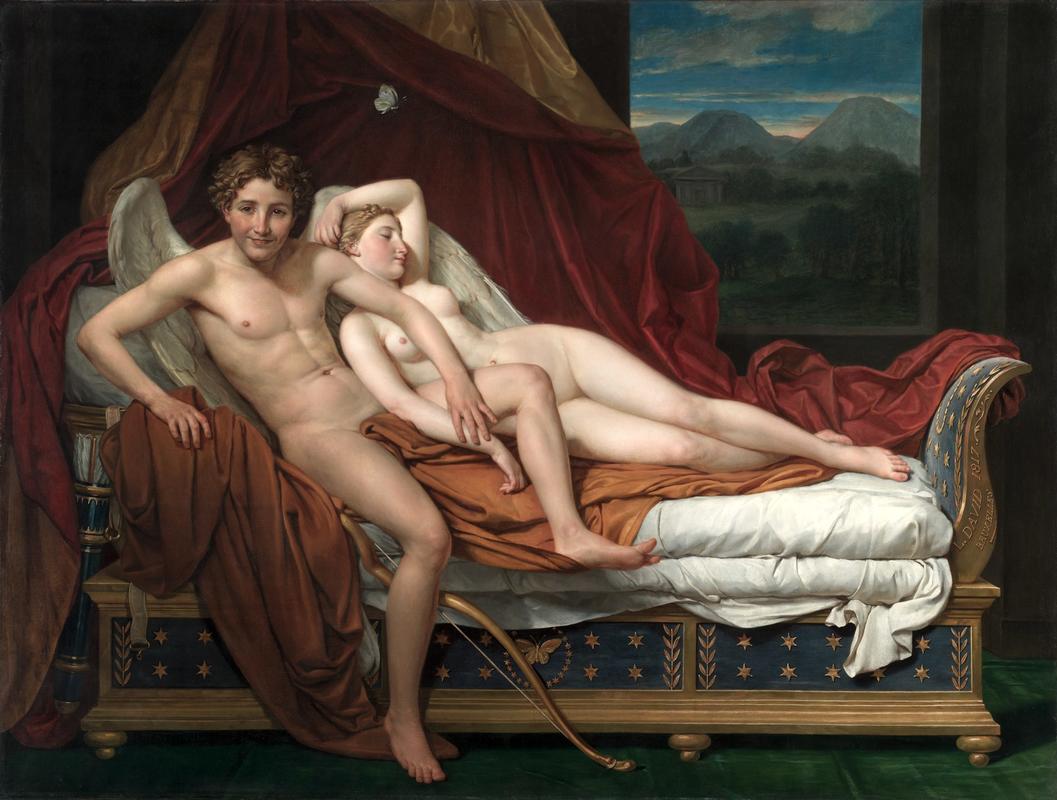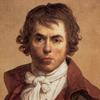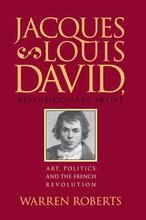More about Cupid and Psyche
- All
- Info
- Shop

Contributor
Teenage love is weird, awkward, and typically involves lots of sneaking around.
Jacques-Louis David captures all this and more in Cupid and Psyche, as a smirking Cupid attempts to lift away Psyche’s arm and sneak off the bed.
While painting Cupid and Psyche isn’t necessarily the most novel of endeavors, David’s take on it was praised for its novelty at the time. Specifically, it was lauded for the realistic approach he used in his depiction of Cupid. It came at a time when everyone else would tend to aim for more heavenly, god-like images in their depictions of mythology.
This painting is one of David’s first post-France-exile paintings, signed Bruxelles (Brussels) on the corner of the couch frame. He was exiled from France in 1814 as a result of the abdication of Napoleon, for his social and political involvement with Napoleon and in his paintings. King Louis XVIII wanted David’s mastery back in France so badly that he offered him a pardon, but it was too late. David stood strong by the principle of the thing and refused to return, staying instead with his other exiled friends in Brussels. At a loss for what direction to go with his art, he turned back to his notebook which was filled with sketches inspired by mythological stories like this one.
The story of Cupid and Psyche, as it appears in Apuleius’s The Metamorphoses (the most likely literary source of David’s painting), goes like this: Cupid falls in love with Psyche who is considered to be the most beautiful woman in the world. Venus, who is Cupid’s mother, grows quickly jealous of Psyche’s beauty (weird Jocasta Complex vibes there) and sends her on a mission to collect Proserpina’s beauty flask from the underworld. Psyche completes her journey, but surprise, the journey holds intentional dangers planted by Venus, which just goes to show you should never trust a parent in a new relationship. Psyche opens the flask (which of course she was told not to do) and falls into an immediate and infinite slumber. Cupid forgives Psyche for her transgression, revives her from her sleep, and falls in love with her. Then he asks Zeus for a big favor. He wants to grant Psyche immortality. Zeus does so and Cupid and Psyche stay together forever in love.
This painting occurs after they’ve married, when Cupid tries to hide his love for Psyche from his mother. But his love simply can’t be contained. He comes over each night to Psyche’s palace, intending to sneak off, but instead he watches her sleep, mesmerized, until he has to leave at dawn.
Sources
- Anonymous. "Cupid and Psyche." Cleveland Museum of Art. July 03, 2019. Accessed July 11, 2019. http://www.clevelandart.org/art/1962.37.
- Anonymous. "A Discussion of Cupid and Psyche by Jacques-Louis David." TripImprover. Accessed July 11, 2019. https://www.tripimprover.com/blog/cupid-and-psyche-by-jacques-louis-dav….
- Francis, Henry S. "Jacques Louis David: Cupid and Psyche." The Bulletin of the Cleveland Museum of Art 50, no. 2 (1963): 29-34. http://www.jstor.org.libproxy.newschool.edu/stable/25151934.
- Vidal, Mary. 1999. “‘With a Pretty Whisper’: Deception and Transformation in David’s Cupid and Psyche and Apuleius’s Metamorphoses.” Art History 22 (2): 214–43. doi:10.1111/1467-8365.00150.
Featured Content
Here is what Wikipedia says about Love and Psyche (David)
Love and Psyche or Cupid and Psyche is an 1817 painting by Jacques-Louis David, now in the Cleveland Museum of Art. It shows Cupid and Psyche. It was produced during David's exile in Brussels, for the patron and collector Gian Battista Sommariva. On its first exhibition at the museum in Brussels, it surprised viewers with its realist treatment of the figure of Cupid. Critics generally saw the painting's unconventional style and realistic depiction of Cupid as proof of David's decline while in exile, but art historians have come to see the work as a deliberate departure from traditional methods of representing mythological figures.
Check out the full Wikipedia article about Love and Psyche (David)













